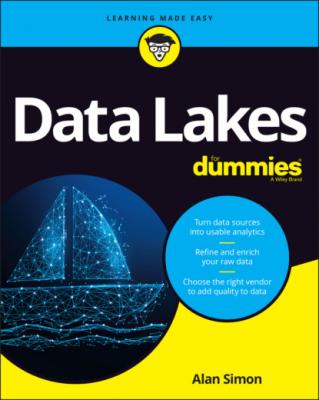Data Lakes For Dummies. Alan R. Simon
Чтение книги онлайн.
Читать онлайн книгу Data Lakes For Dummies - Alan R. Simon страница 19
 fate and build an end-to-end solution. Old habits are extremely difficult to break!
fate and build an end-to-end solution. Old habits are extremely difficult to break!
Suppose that a new chief people officer (CPO) is hired to lead your company’s HR organization. Jan, the new CPO, is a big believer in applying super-advanced analytics, such as machine learning and artificial intelligence, to numerous HR functions: employee evaluations, salary adjustments and promotions, succession planning, and more.
Jan appoints an analytics team within HR and tells them that, within the next three months, they need to have some initial machine learning models built in time for the semiannual employee evaluation cycle. Raul, the analytics teamleader, has been with your company for 15 years and has built several HR-specific data marts in the past for similar needs.
Raul assigns two of the team members, Julia and Dhiraj, to analyze the HR data in Workday (a cloud-based HR and financial management system) to figure out what data needs to be brought into the machine learning model. Raul also assigns another team member, Tamara, to start designing an Amazon Redshift database to store the HR data and support the machine learning algorithms.
Not so fast, Raul!
Raul submits his budget request for the new HR employee incentive evaluation and involvement operations (EIEIO) data mart and is surprised to learn that he needs to present his business case to the company’s new data mart exception board. Raul starts preparing his PowerPoint slides, and comes across item number 2: “State why your analytical needs cannot be met through existing data lake content.”
“Hmm … a data lake,” Raul thinks. “I wonder if the data we need is already in there?”
Sure enough, Raul goes browsing through the data lake catalog and finds that the data lake already has a ton of HR data from Workday that is regularly refreshed. He asks Julia and Dhiraj to match up the work that they’ve done so far with what the data lake catalog shows. Within two hours, they report back with the fantastic news: “Everything we need is in the data lake already!”
A well-constructed data lake offers business users a path of least resistance when it comes to gathering the data they need for their analytical needs. Raul’s team will still need to build the machine learning models to produce the analytics that Jan, your CPO, wants to apply to the next evaluation cycle. But they no longer need to proceed with analytics on a business-as-usual basis, constantly acquiring and storing the same data over and over in different data marts.
Over time, as familiarity with the data lake spreads throughout your organization, fewer unnecessary data mart requests such as Raul’s will need to be redirected back to the data lake. Raul wasn’t deliberately trying to do everything on his own; he just wasn’t familiar enough with what the data lake provided, not only to HR but to your company as a whole.
Establishing a Migration Path for Your Data Warehouses
Data warehousing has been on the scene since around 1990, which means that thousands of enterprise-wide data warehouses have been built and deployed over the years. In fact, looking back at the B-52 analogy earlier in this chapter, you can think of a data warehouse as the equivalent of a propeller-driven airplane that preceded the jet aircraft era, which, of course, makes the data lake the equivalent of that technology-leaping jet.
Sending a faithful data warehouse off to a well-deserved retirement
If your data warehouse is really showing its age, your best bet is to hold a nice retirement party in the company cafeteria with cake and ice cream for everyone and with a few speeches about how wonderful the data warehouse has served the company’s enterprise-wide reporting and business intelligence mission over the years. (Okay, you can probably skip the cake and ice cream, as well as the cafeteria party itself.)
Then you can do the same thing for your data warehouse that you do for any of your creaky, brittle data marts. Build a new set of data feeds from your source applications and systems into the data lake. Then within your data lake, rebuild the data models that your data warehouse used to support business intelligence and reporting alongside machine learning and other advanced analytics (see Figure 2-6).
FIGURE 2-6: Migrating your data warehouse into your new data lake.
Resettling a data warehouse into your data lake environment
Suppose you and your team actually did a fantastic job architecting and building your data warehouse. You did your work and deployed the data warehouse only a few years ago, using fairly modern technology. To put it simply, your data warehouse just isn’t ready for retirement. But you still want to build a data lake to take advantage of modern big data technology. What should you do in this case?
Just as with a solidly built data mart, you can sort of “forklift” a well-architected data warehouse into your data lake environment. You’ll still have to do some rewiring of data feeds, and you’ll be adding complexity to your overall analytical data architecture. But there’s no sense in exiling a solidly built data warehouse into oblivion if it can still deliver value for you for a while to come.
Aligning Data with Decision Making
For better or for worse, the term analytics means different things to different people. As you set out to build your data lake, you need to understand what analytics means to your organization.
Deciding what your organization wants out of analytics
You should think of